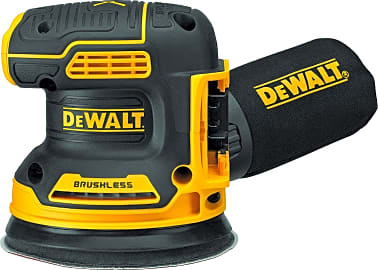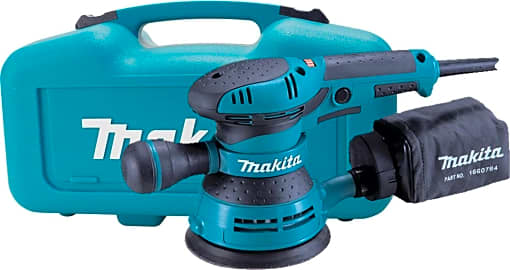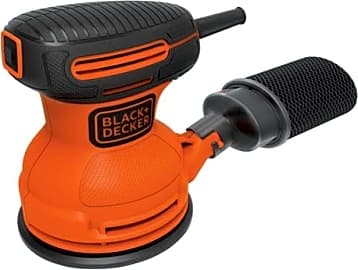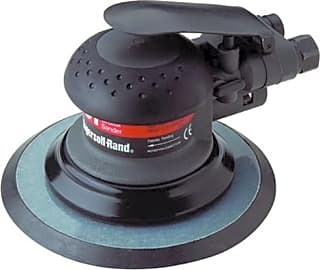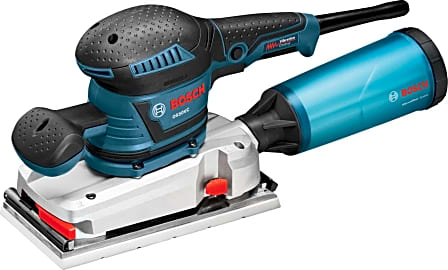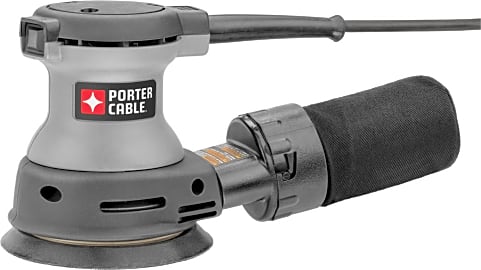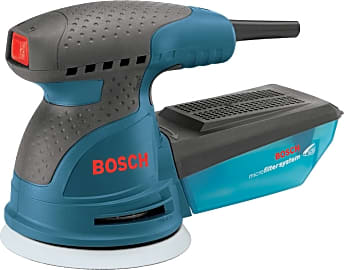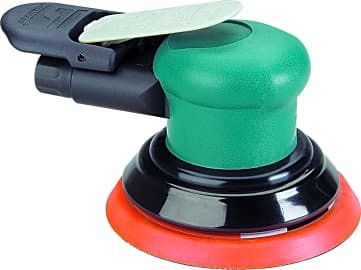The 10 Best Orbital Sanders

This wiki has been updated 47 times since it was first published in March of 2015. If you're in search of the right tool to provide a perfect finish on your next metal or woodworking project, you can depend on one of these compact orbital sanders to help get the job done. We've included a variety of corded and cordless models suitable for both DIYers and professionals alike. Just make sure you follow all the proper safety precautions when operating these devices. When users buy our independently chosen editorial choices, we may earn commissions to help fund the Wiki.
Editor's Notes
July 24, 2020:
We removed both the Bosch 1250DEVS and ROS65VC-6 models due to availability issues.
The pnueumatic 3M Original Series has replaced the Elite model, Its composite body extends down to its base, which helps to reduce excess vibration. Additionally, this one has a recessed lever platform that eliminates pressure points on your palm, which comes in handy for extended sanding sessions. However, be aware that this one is marked for professional and commercial use, so you should be prepared to provide verification if you intend to purchase it.
Newly-added this year is the Festool Rotex, which includes interchangeable round and triangle-shaped sanding pads for accessing corners and tight spaces on various work materials.
We've also included the Bosch OS50VC for its multiple rubber grips and clamping system for easy feeding of standard and stick-on sandpaper supplies.
Finally, we thought the Porter-Cable 382 was worthy of inclusion, thanks to its controlled finishing system for maintaining consistent operating speeds without gouging at startup, making it particularly handy when prepping wood pieces for painting.
July 03, 2019:
Maintained the Bosch 1250DEVS for its turbo and conventional random orbiting modes, giving it the versatility to handle both aggressive sanding and fine polishing tasks. This model is also equipped with a soft start system and 8-foot power cord. Added the Festool ETS 125 for the innovative Vibration Stop balance technology and patented Jetstream design that facilitates efficient dust removal. I also decided to include the DeWalt DCW210B for its extremely low profile, which makes it easy to operate as close to a work surface as possible, and for its reliable brushless motor. For precision work in tight corners, the adjustable front handle and 2-finger trigger switch make the Makita BO5041K worthy of maintaining. Added the Ingersoll-Rand Ultra Duty for its 12,000-RPM motor speed and 1/2-inch diameter holes on its sanding pad, which are well-adept at channeling dust and other airborne contaminants away from the motor. Of additional convenience is its ease of connecting to portable vacuum systems. Maintained the Dynabrade Dynorbital-Spirit due to its 5 rotating blades, floating rotor, and comfort platform for supporting your hands and wrists when using it for extended periods of time. Finally, I added the 3M Elite Series for its lightweight aluminum construction and internal muffler for ensuring quiet operation.
Special Honors
Woodworking Talk If you're looking for ideas, inspiration, suggestions, or help with a DIY project, Woodworking Talk is a good resource through which to communicate. This forum community is dedicated to discussing wood, carpentry, lumber, finishing, tools, and machinery and has several sub-forums for sharing information about various personal projects with power tools, including orbital sanders. woodworkingtalk.com
Minuteman ROS17 While not designed for sanding, per say, the random orbital action of the Minuteman ROS17 does make it an effective solution for cleaning and restoring a variety of floor surfaces. This unit is equipped with a 1.5-horsepower motor, 1,725 RPM micro orbits, and 80-RPM rotation speed. Combining rotary-style scrubbing and orbital oscillation technology, its free-floating base provides constant contact with the ground for even cleaning in as few passes as possible. Finally, its spray tank holds up to 3.9 gallons of cleaning solution. minutemanintl.com
The Right Tool For The Job: The Orbital Sander
Technically known as random orbit sanders, these tools have been in use for well over three decades.
An orbital sander can save you hours of work and prevent the sore muscles associated with laborious hand sanding. These compact and powerful devices use motion and vibration to save you time, while helping produce a smooth, even surface on many types of wood and composite materials.
Technically known as random orbit sanders, these tools have been in use for well over three decades. Unlike a belt sander, which must be constantly moved by its operator to ensure even sanding, the orbital sander operates with two kinds of motion. These include movements in small elliptical patterns and spinning of a disc-shaped head.
Orbital sanders are suitable for use on any wooden surface, regardless of its grain, hardness, or shape. A deft hand is required to prevent the over-sanding of edges, corners, and design elements, but with practice and skill, a good orbital sander can be used on almost any shape or pattern of wood.
Choosing The Right Orbital Sander
For most do-it-yourself types, and even for the devoted hobbyist carpenter, there's no need for a super-powered orbital sander. The higher-end models become more appealing once you begin to deal with large projects, such as finishing work on flooring. Many lower-end orbital sanders don't feature speed control settings, which can be a drawback when working on multiple surfaces.
The shape of a sander plays a big role in how it will best be used. Many orbital sanders are designed to be grasped on their bodies, with one hand controlling the sanding. When more precision is needed, or for those with a weaker grip due to age or infirmity, a model with two grip points might be a better choice. Also, consider sanders with dedicated handles and dual finger triggers if grip is an issue for you. Weight also varies from unit to unit and should be considered by the tool's primary operator.
Beyond speed control, grip and weight, and price tag, consider the fact that some orbital sanders offer more than 3 amps of power, while others offer a half an amp. If that doesn't matter to you, then you're in the half-amp category.
How To Use Your Orbital Sander
Second only in importance to choosing the right tool is choosing the right sand paper for a given job. The higher the grit of paper, the finer (and smaller) its grains of sand will be. High-grit sand paper leaves a smoother, more polished surface and is great for the last few passes of a job.
On the other hand, trying to use fine-grit paper on rough wood or painted surfaces is a waste of time. Choose rough, low-grit sand paper for the first few passes of most projects and pay attention to the paper throughout the process, regularly turning the sander off to check the paper's condition. Sand paper quickly loses its "teeth" and can fill up with paint, dust, and dirt, making it ineffective.
High-grit sand paper leaves a smoother, more polished surface and is great for the last few passes of a job.
The most effective sanding uses lots of sandpaper; just accept that you'll be going through many pads and changing them often. Furthermore, fresher pads mean better work quality with less risk of damage to the surface. And thanks to the hook-and-loop (e.g. Velcro) attachment system used by orbital sanders, switching out sanding pads takes only a few seconds.
To avoid gouging a surface with the edge of the sander (or simply uneven sanding), you need to keep the sander off of the surface on which you're working until it is at full speed and you need to move away from the surface before you turn the device off.
One of the most common mistakes inexperienced craftsman make is to allow a sander to touch a surface when it's not at full speed, leading to uneven pressure along the edges. Of course, it's the moment of initial contact that is most likely to cause damage to a surface, even when the sander is running at full speed. A firm and steady grip is critical, as is knowing which way your sander is going to pull your hands when it first touches down.
You would be wise to practice sanding plenty of surfaces -- both wide, flat surfaces as well as edges and corners -- before you ever work on a prized piece of furniture or an elegant piece of molding. Pallet wood is cheap and rough, and makes a great practice surface, as does any leftover lumber at a building site. Just watch out for nails, screws, and staples, as even the most industrious orbital sander can't handle metal.


